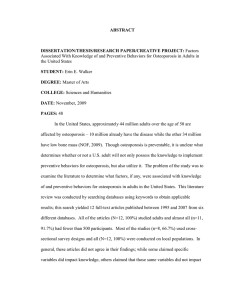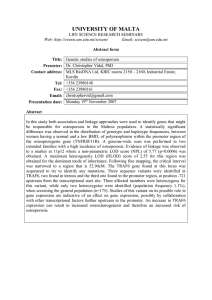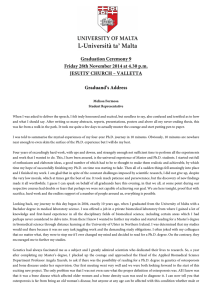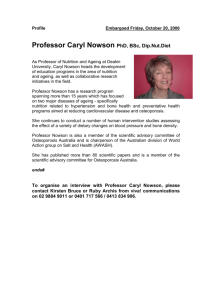Document 14249278
advertisement
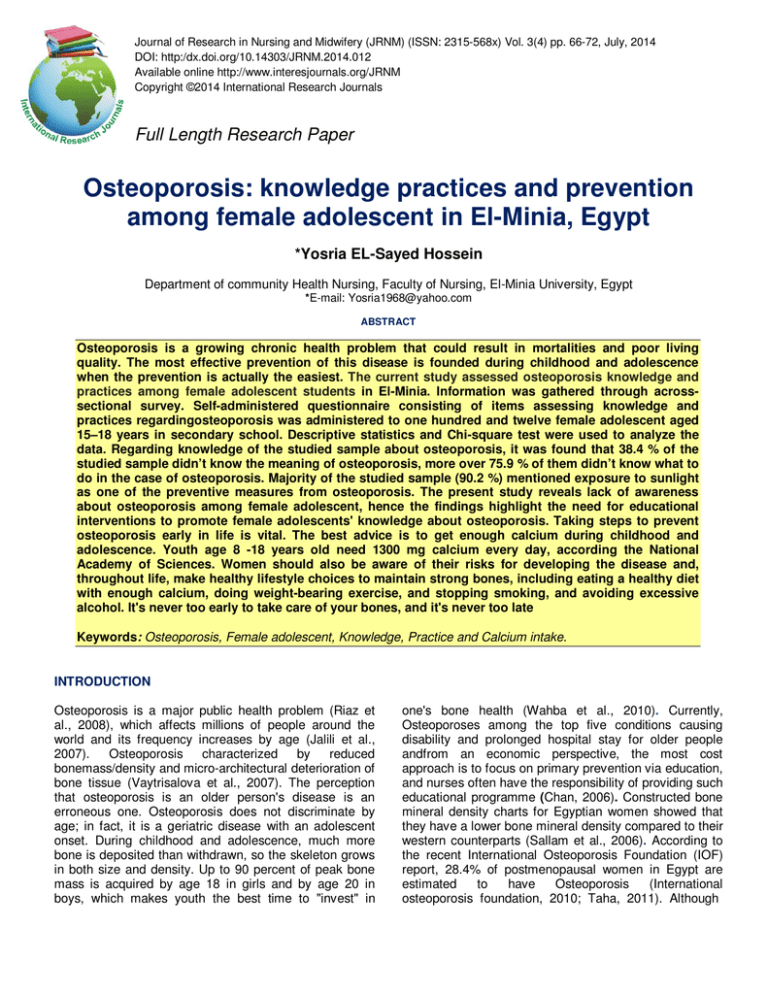
Journal of Research in Nursing and Midwifery (JRNM) (ISSN: 2315-568x) Vol. 3(4) pp. 66-72, July, 2014 DOI: http:/dx.doi.org/10.14303/JRNM.2014.012 Available online http://www.interesjournals.org/JRNM Copyright ©2014 International Research Journals Full Length Research Paper Osteoporosis: knowledge practices and prevention among female adolescent in El-Minia, Egypt *Yosria EL-Sayed Hossein Department of community Health Nursing, Faculty of Nursing, El-Minia University, Egypt *E-mail: Yosria1968@yahoo.com ABSTRACT Osteoporosis is a growing chronic health problem that could result in mortalities and poor living quality. The most effective prevention of this disease is founded during childhood and adolescence when the prevention is actually the easiest. The current study assessed osteoporosis knowledge and practices among female adolescent students in El-Minia. Information was gathered through acrosssectional survey. Self-administered questionnaire consisting of items assessing knowledge and practices regardingosteoporosis was administered to one hundred and twelve female adolescent aged 15–18 years in secondary school. Descriptive statistics and Chi-square test were used to analyze the data. Regarding knowledge of the studied sample about osteoporosis, it was found that 38.4 % of the studied sample didn’t know the meaning of osteoporosis, more over 75.9 % of them didn’t know what to do in the case of osteoporosis. Majority of the studied sample (90.2 %) mentioned exposure to sunlight as one of the preventive measures from osteoporosis. The present study reveals lack of awareness about osteoporosis among female adolescent, hence the findings highlight the need for educational interventions to promote female adolescents' knowledge about osteoporosis. Taking steps to prevent osteoporosis early in life is vital. The best advice is to get enough calcium during childhood and adolescence. Youth age 8 -18 years old need 1300 mg calcium every day, according the National Academy of Sciences. Women should also be aware of their risks for developing the disease and, throughout life, make healthy lifestyle choices to maintain strong bones, including eating a healthy diet with enough calcium, doing weight-bearing exercise, and stopping smoking, and avoiding excessive alcohol. It's never too early to take care of your bones, and it's never too late Keywords: Osteoporosis, Female adolescent, Knowledge, Practice and Calcium intake. INTRODUCTION Osteoporosis is a major public health problem (Riaz et al., 2008), which affects millions of people around the world and its frequency increases by age (Jalili et al., 2007). Osteoporosis characterized by reduced bonemass/density and micro-architectural deterioration of bone tissue (Vaytrisalova et al., 2007). The perception that osteoporosis is an older person's disease is an erroneous one. Osteoporosis does not discriminate by age; in fact, it is a geriatric disease with an adolescent onset. During childhood and adolescence, much more bone is deposited than withdrawn, so the skeleton grows in both size and density. Up to 90 percent of peak bone mass is acquired by age 18 in girls and by age 20 in boys, which makes youth the best time to "invest" in one's bone health (Wahba et al., 2010). Currently, Osteoporoses among the top five conditions causing disability and prolonged hospital stay for older people andfrom an economic perspective, the most cost approach is to focus on primary prevention via education, and nurses often have the responsibility of providing such educational programme (Chan, 2006). Constructed bone mineral density charts for Egyptian women showed that they have a lower bone mineral density compared to their western counterparts (Sallam et al., 2006). According to the recent International Osteoporosis Foundation (IOF) report, 28.4% of postmenopausal women in Egypt are estimated to have Osteoporosis (International osteoporosis foundation, 2010; Taha, 2011). Although Hossein 67 genetic factors (e.g., age, race, family history, and gender) are major determinants of peak bone mass and subsequent bone status, Osteoporosis is one of diseases which are influenced by nutrition and lifestyle, it is preventable by means of adequate nutrition and sufficient physical activity (Stransky and Rysava, 2009). Because lifestyle practices formed early in life and may be carried into adulthood, there is an immediate need to increase osteoporosis awareness and subsequent beliefs, not only in older women, but also in younger women (Siegrist, 2008; Miura et al., 2010). Osteoporosis includes several controllable and uncontrollable risk factors, the controllable risk factors (environmental) include low activity level, sedentary lifestyle over many years, smoking, alcohol abuse and inadequate diet including eating disorder, low calcium intake, low vitamin D intake. Excessive consumption of soft drinks and caffeinated drinks cause calcium loss via the kidney. Caffeine use of more than three cups of coffee every day might increase calcium excretion in the urine and it affects bone health.the uncontrollable factors includes gender, family history, ethnicity and race, advancing age, postmenopausal status and body frame size (National osteoporosis foundation, 2011). During adolescence, a human’s bone structure becomes strong and an adequate bone mass is increased. During childbearing period, women have maintained a certain amount of bone mass due to production of Estrogen hormone which protect against bone loss. However after menopause, the ovaries discontinue to product estrogen. Women’s estrogen levels decrease dramatically at menopause. Therefore the osteoporosis risk factors for women are irregular menstruation period, amenorrhea, early menopause, and reduced estrogen after menopause (Rodzik, 2008). Achieving a higher peak bone mass through exercise and proper nutrition during adolescence is important for the prevention of osteoporosis. Exercise and nutrition throughout the rest of the life delays bone degeneration. Jogging, walking, or stair climbing at 70-90% of maximum effort three times per week, along with 1,500 mg of calcium per day, increased bone density of the lumbar (lower) spine by 5% over nine months. Individuals already diagnosed with osteopenia or osteoporosis should discuss their exercise program with their physician to avoid fractures (Osteoporosis Australia, 2011). Based on recent research, considerable number of adult males and females are unaware about osteoporosis. There is deficiency in knowledge and poor application of the preventive actions; therefore, health education is needed to improve awareness and motivating healthy behaviours (Barzanji, 2013). Early assessment and prevention programs should start at an early age to avoid the behavioral risk factors (Cline& Worley 2006). Effective community–based educational programs proved to have profound effect on improvement of knowledge and health behavior related to osteoporosis and its care (Chang, 2006-a). Significance of the study Osteoporosis is a significant global public health issue, expected to affect more people worldwide than ever by 2050. It is no longer confined to the growing older population but has implications for all age groups. Public awareness of osteoporosis remains low, especially in less developed countries. Health education have been shown to be effective in improving knowledge and awareness among the publicand schools can be one of the best venues for increasing knowledge of osteoporosis and inducing lasting behavioral change during adolescence; the period of peak bone density.In Egypt, there is scarcity of local studies which discuss the level of awareness toward osteoporosis, in both females and males members, thereforethe present study aimed to assess knowledge and practices about osteoporosisamong female adolescent in El-Minia governorate. SUBJECTS AND METHOD Descriptive design was utilized in this study, which conducted among convenience sample of one hundred twelve female adolescent in secondary school in ElMinia, Egypt. Data collection Prior to data collection, the necessary approval consent was secured from the director of El-Minia secondary school. In addition, the purpose of the study was explained to students and their agreementwas obtained.The time required to complete the questionnaire was about 20 to 30minutes. Data was collected from November 2012 to February 2013throughstructured interview, the researcher went to the secondary school two times per week (Monday and Wednesday) and each participant interviewed individually. Tool of the study The questionnaire was developed by the researchers based on reviewing the literature, it consisted of67 questions; coveringfive parts; the first part (4questions) related to social and personal characteristics of the study sample (age, residence, marital status, and ways of travelling to the school). The second part (9 questions) related to knowledge about menstruation, pregnancy and lactation. The third part (8 questions) related to family and disease history, The fourth part (35questions) included knowledge about osteoporosis. The fifth part (11 questions) included student’s practices toward 68 J. Res. Nurs. Midwifery Table 1. Demographic characteristics of the studied sample Characteristics Ae ( years): 15 - < 17 17 – 18 Range Mean ± SD Residence : Rural Urban Marital status : Single Married Ways of travelling to the school : By bus / car On feet Frequency(N = 112) Percentage 10 102 8.9 91.9 (15-18) 17.2 ± 0.7 86 26 76.8 23.2 110 2 98.2 1.8 101 11 90.2 9.8 Table 2. Participant’s history of osteoporosis Variable Family history of Osteoporosis Yes No Have you had inflammation in the joints Yes No Have you had difficulty in walking Yes No Have you had lower back pain Yes No Have you had muscle’s weakness Yes No No % 11 101 9.8 90.2 24 88 21.4 78.6 39 73 34.8 65.2 53 59 47.3 52.7 31 81 27.7 72.3 osteoporosis. RESULTS Ethical Considerations Ethical approval was obtained from the administration of educational region of the participated school and theconfidentiality of information was maintained by assigning identification numbers. The participating students did get written and oral information before the start of the study. They were informed about the right to quit at any time without the need for an explanation and without any consequences for them. The participants gave written informed consent before entering the study. Statistical Analysis Data entry and analysis were done using the statistical software program SPSS version 16. The data were presented in the form of percentages and mean ± standard deviation. P value less than 0.05 was considered significant Out of 150 female adolescents, who accepted to participate in the study, 112 completed the questionnaire (74.7 % response rate).The characteristics of the participants were shown in table (1). The mean age of the participants was 17.2 ± 0.7 years and the majority of them (91.9 %) their age ranged between 17 and 18 years. Regarding their residence more than three quarters of the studied sample were from rural area (76.8 %) and most of them (98.2 %) were single and travelling to the school by bus/car (90.2%). As regards to participant’s history of osteoporosis, table 2 demonstrates that the highest percentage of the studied sample (90.2%) had nofamily history of the disease. More than three quarters of the sample (78.6%) had no inflammation in the joints and34.8 % had difficulty in walking.As well as more than half of the studied sample had no low back pain or weakness in their muscles (52.7% and 72.3% respectively). Hossein 69 Table 3. Knowledge of participants related to Osteoporosis Item Meaning of Osteoporosis Don’t know a medical condition caused by lack of bone density Bony protrusion appear in certain places Inability to walk Bone atrophy affects the body Proper action in case of osteoporosis Don’t know Taking calcium and avoid taking soft drinks Follow up with doctors Bed rest Taking calcium and vitamins Most susceptible gender to osteoporosis Don’t know Male Female Bones more likely to break Don’t know Pelvis Thigh Shoulder Leg Wrist Do osteoporosis occurs suddenly Yes No Age more affected with osteoporosis Don’t know Children Old age Middle age At any age Number(N = 112) % 43 41 2 10 16 38.4 36.6 1.8 8.9 14.3 85 14 9 3 1 75.9 12.5 8.0 2.7 0.9 57 3 52 50.9 2.7 46.4 49 13 13 3 21 13 43.8 11.6 11.6 2.7 18.8 11.6 18 94 16.1 83.9 28 11 48 3 22 25.0 9.8 42.9 2.7 19.6 60 48.4 50 40 29.8 % 30 20 8.9 5.7 5.4 10 1.8 0 Don't know Being female Early menopause Old age Low calcium Excess in intake drinking soft drinks Figure 1. Percentage of students' knowledge regarding risk factors for osteoporosis Concerning knowledge of the studied sample about osteoporosis; it was found that 38.4 % of the studied sample had no knowledge regarding the meaning of osteoporosis, more over 75.9 % of them didn’t know the proper action in case of osteoporosis and 46.4 % of them stated that female more susceptible to osteoporosis (table 3). As given in figure (1) regarding the risk factors for 70 J. Res. Nurs. Midwifery Table 4. Frequency percentage of students who identified preventive measures for osteoporosis correctly preventive measures Exposure to sun light Eating dietrich in calcium & vitamin D Regular exercise Limit the intake of tea and coffee No 101 8 106 6 % 90.2 7.1 94.6 5.4 More than one choice was available Table 5. Knowledge of participants related to nutrition Variable Food identified by participants as a rich source of calcium Dairy products: milk Yogurt Recommended consumption Monthly Weekly Daily Meat and fish Poultry meat (chicken meat) Liver Domestic fish Sardines Eggs Recommended consumption Monthly Weekly Daily Other food Beans vegetables developing osteoporosis, being a female and advanced age were the most common identified risk factors (48.4% and 29.8% respectively). Low calcium intake and early menopause were confirmed by 5.7% and 5.4% as risk factors. Excess in drinking of soft drinks was recognized by only 1.8% of the respondents, while 8.9% of students didn't know the risk factors for developing osteoporosis. Most of participants identified regular exercise and exposure to sun light as preventive measures for osteoporosis (94.6% & 90.2% respectively), meanwhile only 7.1% could identify eating diet rich in calcium and vitamin (D)as a preventive measure (table 4). As regards to knowledge of the studied sample about foods that rich incalcium, it was found that the majority of the studied sample (99.1%) stated milk and 76.8 % of them recommended its daily consumption. Regardingto meat and fish,28.6% of participants reported poultry meat as a rich source for calcium and 50.9 % of them stated it should consumed daily (table 5). Knowledge and practices of physical activity are illustrated in table 6, one hundred and six students (94.6%) were aware of the benefits of exercise in preventing osteoporosis, yet 58% were engaged in some sort of physical activity not on a regular basis as they No % 111 1 99.1 0.9 13 13 86 11.6 11.6 76.8 32 8 18 9 45 28.6 7.1 16.1 8.0 40.2 9 46 57 8.0 41.1 50.9 75 30 67.0 26.8 reported. . DISCUSSION Osteoporosis has recently been recognized as a major public health problem (Kustal et al., 2005), it is no longer confined to the growing older population but has implications for all age groups (Hannon 2007). Hence increasing knowledge of osteoporosis should be a priority for future intervention programs in order to promote specific behavioral strategies for osteoporosis prevention (Alexandraki et al., 2007). The purpose of this study was to explore the extent of osteoporosis knowledge and practices among adolescent female school students in ElMinia. Only 36.6% of participants had known the meaning of osteoporosis, the same results were obtained among the Turkish women by Gemalmas and Oge (2008) and also among Taiwani young adult women by Chang (2006-b). On the other hand higher proportions were obtained by Alexandraki et al (2007) and Yeab et al (2010), who conducted their studies in Malaysiaand Greece respectively. Hossein 71 Table 6. Physical exercise knowledge and practices Item Regular exercise can protect against osteoporosis Yes No Do you practice physical exercise Yes No If yes, sort of exercise Walking Running Sports training Volley ball Times/wk (3 times) Duration (15-30 minutes/time) Regarding the risk factors for developing osteoporosis, results of the presents study revealed that the studied sample were aware of the risk factors and this agreed with National osteoporosis foundation (2011) which mentioned that risk factors that increase or cause osteoporosis include gender, family history, advancing age , post menopausal status and excess in soft drinks. According to Chan (2006), exercise and walking programmes can help build stronger bones and muscles and can be used to increase strength, flexibility and balance. Based on our findings, students knew that regular exercise can protect against osteoporosis, but this knowledge does not translate to practices; nearly one-half of the students were exercising at a minimal level and not on regular basis. When identifying good sources of calcium, the studied sample answered buffalo milk (99.1%) as dairy products and this agreed with the result of Fok et al (2008) who mentioned that people can get calcium from milk products and calcium rich diet. The majority of the studied sample (90. 2%) knew that exposure to the sun is good for bone and this agreed with Insel et al (2004) who found that usually 10-15 minutes exposure of the hands, arms and face two or three times a week is enough to satisfy the body’s vitamin D requirement. In order to meet the challenges and threats of osteoporosis, prevention efforts need to be geared to young girls and women. In this regards, defective knowledge about preventive measures for osteoporosis was observed in this study as regards to eating diet rich in calcium and vitamin D and also regarding limitation of the intake of tea and coffee. This was in an agreement with Cadarette et al (2007) from Canada who reported significant knowledge deficit in the areas of osteoporosis consequences and prevention. In conclusion, the present study reveals lack of awareness about osteoporosis among female adolescent, sothe study could serve as a stimulant for further researchers to assess knowledge and other practices toward preventive measures among other age groups. Ministry of Education should be No % 106 6 94.6 5.4 65 47 58 42 61 1 2 1 39 51 54.5 0.9 1.8 0.9 34.8 45.6 involved in health education about osteoporosis and its related factors in schools or even could provide educational program via their curriculum to improve the awareness of this disease among students and thus ensuring that they received accurate information CONCLUSION The present study reveals lack of awareness about osteoporosis among female adolescent, hence the findings highlight the need for educational interventions to promote female adolescents' knowledge about osteoporosis. RECOMMENDATION Our study recommended that serious measures to be undertaken to prevent osteoporosis to stop any future epidemic of catastrophic osteoporosis-related fractures. Taking steps to prevent osteoporosis early in life is vital. The best advice is to get enough calcium during childhood and adolescence. Youth age 8 -18 years old need 1300 mg calcium every day, according the National Academy of Sciences. Women should also be aware of their risks for developing the disease and, throughout life, make healthy lifestyle choices to maintain strong bones, including eating a healthy diet with enough calcium, doing weight-bearing exercise, and stopping smoking, and avoiding excessive alcohol. It's never too early to take care of your bones, and it's never too late. REFERENCES Alexandraki KI, Syrion V, Ziakas NV, Piperi E, Kavoulaki I, Korres E(2007). The knowledge of osteoporosis risk factors in a Greek female population, Maturitas. 59(1):38-45. Barzanji AT, Alamri FA, Mohamed AG(2013). Osteoporosis: A Study of Knowledge, Attitude and Practice among adults in Riyadh, Saudi Arabia. J. Community Health. 38:1098-1105. 72 J. Res. Nurs. Midwifery Cadarette SM, Gignac MA, Beaton DE, Jaglal SB, Hawker GA(2007). Psychometric properties of the osteoporosis and you, questionnaire: osteoporosis knowledge deficits among elder community-dwelling women. Osteopor. Int. 18(7): 981-989. Chan MF(2006). Osteoporosis prevention education programme for women. J. advanced Nur. 54(2): 159-170. Chang SF(2006-a). Knowledge, health belifes and behaviours in first – degree relatives of women suffering from osteoporosis. J. Clin. Nur. 15(2): 227-229. Chang SF(2006-b). "A cross-sectional survey of calcium intake in relation to knowledge of osteoporosis and beliefs in young adult women." Int. J. Nur. Practice. 12: 21-27. Cline RR, Worley MM(2006). Osteoporosis health beliefs and self-care behaviors: an exploratory investigation. J. AM. pharm. Assoc. 46(3): 356-364. Fok MW, Leung HB, Lee WM(2008). Osteoporosis: public awareness, commitment, and perspective. Hong Kong Med. J. 14(3): 203-8. Gemalmaz A, Oge A(2008). Knoweldge and awareness about osteoporosis and its related factors among rural Turkish women. Clin. Rheumatol. 27(6): 723-8. Hannon C(2007). A survey of nurse's and midwives knowledge of risks and life style factors associated with osteoporosis. vol. 18 suppl. 3 osteoporosis Int. 265: 7A. Insel P, Turner RE, Ross D(2004). Nutrition, 2nd edition. Jones and Bartlett Publishers, Sudbury, Massachuselt. Pp. 89 – 104. International osteoporosis foundation (2010). Available at http://www.iofbonehealth.org/ (accessed 13 Feb. 2013). Jalili Z, Nakhaee N, Askaril R, Sharifi V(2007). Knowledge, attitude and preventive Practice of women concerning osteoporosis. Iranian J. Public Health. 36: 19-24. Kustal YG, Atalay A, Arslan S, Basaran F, Canturk A, Cindas M, Eryavuz J, Sindel K(2005). Awareness of osteoporotic patients. Osteopor. Int. 16(2): 128-33. Miura S, Yagi M, Saavedra OL, Yamamoto S(2010). Sociodemographic variation in knowledge of osteoporosis and locally available calciumrich foods among urban women living in Davao, Philippines. Health Care Women Inter. 31(5): 378-401. National osteoporosis foundation (2011). Available at. http://www.nof.org/node/150(accessed 11 January 2013). Osteoporosis Australia (2011). Available at http://www.osteoprosis.org.au (accessed 8 December 2012). Riaz M, Patel J, Tariq M, Khan MS, Zuberi L, Abid N(2008). Knowledge about Osteoporosis among healthy women attending a tertiary care hospital. J. the Pakistan Med. Assoc. 58: 190-194. Rodzik E(2008). Osteoporosis education in college- age of women. Eastern Michigan University Masters Thesis. Pp. 5-9. Sallam H, Galal AF, Rashed A(2006). Menopause in Egypt: past and present perspectives. Climacter. 9(6): 421-429. Siegrist M(2008). Role of physical activity in the prevention of osteoporosis. Med Monatsschr. Pharm. Jul. 31(7): 259-64. Stransky M, Rysava L(2009). Nutrition as prevention and treatment of Osteoporosis. Physiol. Res. Suppl. 58(1): S7-S11. Taha M(2011). Prevalence of osteoporosis in Middle East: systemic literature Rev. 10th ECOO, April 2011. Available at http://www.scribd.com/doc (accessed 20 June 2012). Vaytrisalova M, Kubena A, Vleek V, Palicka T, Hala T, Pavelka K(2007). Knowledge of osteoporosis correlated with hormone therapy use and health status. Matur. 56(1): 21-29. Wahba SA, Abd El-Shaheed A, Tawheed MS, Mekkawy AA, Arrafa AM(2010). Osteoporosis knowledge, beliefs, and behaviors among Egyptian female students. J. the Arab Society for Med. Res. 5(2): 173-180. Yeab SS, Goh EM, Das GE(2010). Knowledge about osteoporosis in Malaysia population. Asia Pac. J. Public Health. 22(2): 233-410. How to cite this article: Hossein Y.S. (2014). Osteoporosis: knowledge practices and prevention among female adolescent in El-Minia, Egypt. J. Res. Nurs. Midwifery 3(4):66-72
